Longnose Hawkfish, scientifically known as Oxycirrhites typus, is a popular marine water aquarium fish that has its native habitat in the tropical reefs of both the Indian and Pacific Oceans. In the ocean, it is usually found in depths that can be as deep as 10 to 100 meters deep. In the past, the fish had a reputation for being expensive and difficult to find in the market. Things have now changed and now the fish is more readily available in pet shops and the cost is also more affordable.
The Indian and Pacific oceans are home to the Longnose Hawkfish, distributed alongside tropical reefs. We can locate them at depths ranging from 10 to 100 meters in the wild, but a 30-gallon tank is all we require for water aquariums. These fish have a reputation for being tough and expensive to obtain in the past.
On the other hand, Longnose Hawkfish is a famous saltwater species with a distinctive cylindrical body that stands out in the commercial fish trade.

Their unique perching method and vibrant colors make them an excellent addition to any marine aquarium. They’re intelligent fish with a lot of energy and personality — as long as you have enough space.
It has become a big favorite for most hobbyists due to its high tolerance to diseases, high level of intelligence, and its colorful body. The fish can sometime get frisky and needs to be provided with plenty of rocky hiding places within the tank. Because the fish is highly territorial it is best to introduce it into a community aquarium last to avoid the possibility territorial aggression. If you are going to keep the fish in the same tank with other fish, it best to choose the tank mates.
The fish is a highly aggressive predator who will easily feed on other small fish as well as invertebrates.
The fish has got a very long snout and features a tuft of cirri that is found just next to the tip of each the dorsal spine. The tail fin of the fish is concave-like in shape. Awkwardly though, the fish lacks a swim bladder which anyway is a characteristic of all other members of the fish that belong to the Cirrhitidae family.
The fish has got impressive patterns that adorn its body from the head to its tail fin. The colors of the patterns on its body are red and white that form markings that are mottled. The fish usually grows to a maximum of five inches in total length and features patterns all over its body that resembles those on other fish such as scorpion fish, rockfish, and lionfish.
Please note that the adult males of the fish have a characteristic fringing on their pelvic and caudal fins.
Table of Contents
Longnose Hawkfish: A Brief Introduction
Longnose hawkfish (Oxycirrhites Typus) are small, brightly colored saltwater fish native to the reefs of the Indo-Pacific region. They are popular in the aquarium trade due to their striking appearance and relatively peaceful nature. Longnose hawkfish require a tank with plenty of live rock for hiding and perching, as well as a diet of small, meaty foods.
Longnose Hawkfish Overview
Most enthusiasts prefer the Longnose Hawkfish because it has a strong immune system and can resist infections.
Interestingly, these species are pelagic spawners in the wild and nesters in a home aquarium.
It has peculiar behavioral features that are unique to it. Finally, their vibrant patterns make them popular among fishkeepers since they brighten up even the drabbest tanks.
| Information Chart | Longnose Hawkfish |
|---|---|
| Scientific Name: | Oxycirrhites typus |
| Family: | Cirrhitidae |
| Care Level: | Easy to Intermediate |
| Temperament: | Semi-aggressive species |
| Lifespan: | 10 years |
| Size: | 5 inches |
| Diet: | Carnivorous |
| Minimum Tank Size: | 30 gallons or larger |
| Temperature: | 76-80° F |
| Water Conditions: | pH between 8.1 and 8.4. You should also keep water hardness in the tank between 8 and 12. |
| Tank Mate Compatibility | Semi aggressive with smaller fish |
Longnose Hawkfish Appearance
The Longnose Hawkfish does have a long snout and a thin body with characteristic grid patterns made up of near-vertical horizontal lines that give the fish a checkerboard appearance.
The tuft of cirri around the tip of every dorsal spine is one feature that strikes out right away. Their tail fin features a concave curve that is distinctive to them. The caudal fin displays a spectrum of colors that are difficult to miss.
One dorsal fin contains ten spines, two to four cirri near the apex of every dorsal spine, and one anal fin has three to seven rays. Like other Cirrhitidae species, the Longnose Hawkfish conserves energy by sitting on rock ledges with pectoral fins.
Teeth are shaped conically to aid in the rapid capture of tiny invertebrates and crustaceans. Longnose Hawkfish has a maximum size of 4 to 5 inches for both females, making them suited for smaller aquariums.
Without the help of an expert, distinguishing men from females can be difficult.
Males have black stripes on their dorsal fins and are generally significantly larger than females.
Lifespan of Longnose Hawkfish
Longnose hawkfish lives for 5-7 years on the reefs of the Indian and Pacific oceans. You may expect your small fish to live the same amount of time with adequate care and a high-quality diet.
Longnose Hawkfish Size
Longnose hawkfish grow to be about 5 inches long. If you’re going to harvest your fish, keep in mind that the hawkfish family lacks swim bladders. This implies they are decompressed quickly after being captured.
That’s a big plus because it saves you time waiting for the catch to decompress in choppy seas, especially if it’s from greater depths and takes a long time to acclimatize.
Native Habitat and Natural Distribution in the Wild
The original natural habitat for the fish is the Indo-Pacific as well as the East Pacific. In the Indo-Pacific, the geographical distribution of the fish extends from the Red Sea and South Africa waters to Hawaii. This range goes as far north as the southern parts of Japan and also as far south as parts of New Caledonia.
In the eastern Pacific region, the fish is found between the Gulf of California to the northern coast of Colombia as well as the Galapagos Islands.
In the waters, the fish is usually found in depths of from 10 meters to 100 meters. The Longnose Hawkfish specifically likes to hang in areas of the water with steep outer reef slopes that usually have strong currents. The fish prefers to perch itself on black corals and Gorgonians where it waits for small fish and invertebrates to feed on.
Hawkfish are primarily found in the Indo-Pacific, with two species in the tropical eastern and western Atlantic Oceans. Most species are located in shallow water, while some can flow deep up to a few hundred feet deep.
The longnose hawkfish can be found all over the tropical Indo-Pacific, including the Red Sea, off the coast of eastern Africa to southern Japan, Noumea to the eastern Pacific, and the lower third of the Sea of Cortez, from northern Colombia to the Galapagos Islands.
The fish is rarely seen throughout its range, and finding it sometimes necessitates diving deep outside reef slopes and searching for big gorgonians and black coral formations.
Longnose Hawkfish Care & Tank Set-Up
The fish needs to be housed in a tank that is at least thirty gallons with lots of rocks and corals to replicate the natural environment where it lives in. It is on these rocks that the fish likes to perch itself on. The water temperature in the tank needs to be set to be around 24 – 26°C. Please note that this temperature range is almost the same as that it experiences while in the wild.
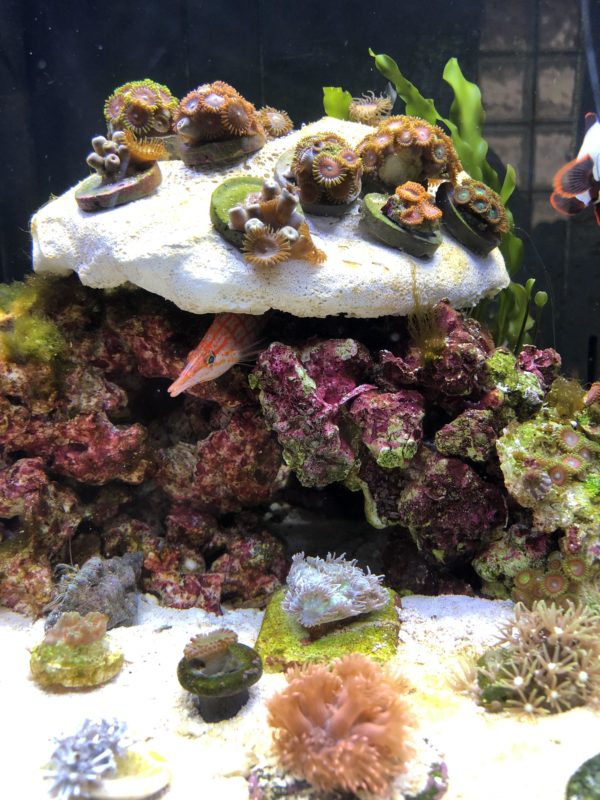
Never house the fish with other species of fish that are too small to be eaten by it. It is a highly aggressive predator fish that will easily eat small fish! Longnose Hawkfish is not known to like eating crustaceans but because it is an aggressive predator don’t take chances with it by placing it in the same tank with your crustaceans.
Don’t house the fish in a tank with corals that have strong stings i.e. Sea Anemones or Catalaphyllia. These may kill the fish easily! Ensure that the water is salty because the fish is a marine water fish. The lighting in the tank should be moderate as the fish is sometimes found in depths of 300 feet.
Performing water changes on a regular basis is the best thing to do in order to provide the fish an optimum environment.
Longnose Hawkfish Tank Size and Specifications
Optimum Tank Size for Longnose Hawkfish
A 30-gallon tank or larger is recommended, a tight-fitting lid to avoid escape. The Longnose Hawkfish is a robust, semi-aggressive fish, although it will be overpowered by larger hawkfish.
Even though it consumes shrimp and small fish, it makes a great reef resident in the right circumstances.
Substrate
They prefer rocky environments with crevices for concealment and algae growth for food. These are bottom dwellers. Thus, it’s better to keep them near a medium-sized gravel substrate or fine sand.
If you maintain the hawkfish on a gravel substrate, include some larger diameter rocks, so he has somewhere to hide if he feels threatened.
Water Parameters for Longnose Hawkfish
Water Temperature
The ideal water temperature for Longnose Hawkfish is 76-80° F.
Ph Level
Longnose Hawkfish is a saltwater fish, so apply appropriate salts in the tank and keep the pH between 8.1 and 8.4.
Water Hardness
You should keep the water hardness in the tank between 8 and 12. Hawkfish should have a well-balanced diet, and it would be ideal if you could give crustaceans.
Longnose Hawkfish Tank Landscape
Best Plants for Longnose Hawkfish Tanks
Think about adding a few saltwater plants to the tank to improve the oxygenation and make it more beautiful. The following is a list of good plants for the Longnose Hawkfish:
Halimeda
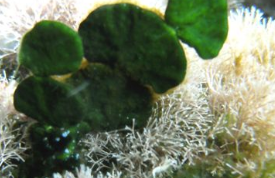
Halimeda can be seen in waters worldwide and adapt to any situation. The Money Plant gets its name from its oval-shaped leaves, which resemble coins. They are resilient and can survive in various conditions, but they do not thrive in high-nitrate situations.
Tufted Joint Algae
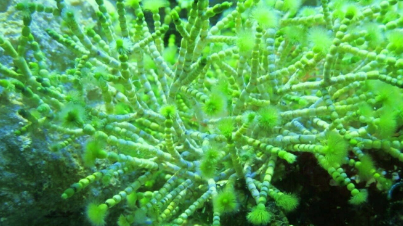
These plants aid in maintaining a healthy aquarium. Their small, segmented leaves are interesting and enhance the Longnose Hawkfish’s distinctive appearance.
Tufted Joint Algae are excellent in balancing the nitrogen cycle in the water and increasing the amount of oxygen in the tank. For the best effects, they should be fixed to the substrate and require moderate water flow.
Blue Hypnea Algae
These are the most unusual plants you can put in a saltwater aquarium. The iridescent blue color of the Blue Hypnea Algae provides a lot of visual appeal to a tank.
They grow slowly and are thickly packed in tiny clusters. For healthy development, this plant requires high-spectrum illumination and protection from the substrate.
They’re excellent at absorbing surplus nutrients from the tank, making them ideal for Longnose Hawkfish.
Worst Plants for Longnose Hawkfish Tanks
Dragon’s Tongue Algae
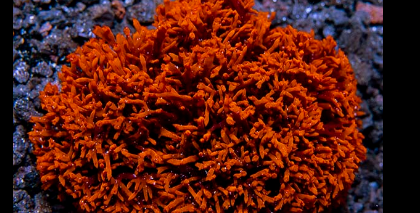
Their brilliant orange color contrasts with the checkered patterns on your Hawkfish and gives variety to the visuals. In the appropriate conditions, they grow quickly, which isn’t a good thing if your tank isn’t big enough.
Red Mangrove Propagule
They may be found in many tropical oceans worldwide, and they can adapt to aquariums just as quickly as they do in the wild. Their propagules can reach a length of 8 inches and mimic tall candles. These plants may contend with the Hawkfish for habitat and increase their stress levels if they are allowed to develop excessively.
Lighting For Longnose Hawkfish Tanks
They prefer dim lighting. The lighting in the tank must be moderate because sometimes fishes are below 300ft in the water and moderate lightning will perfectly suit their sensitive eyes. And dim lighting will give you a chance to see their hunting behavior.
Nitrogen/Other Nutrient Requirements for Longnose Hawkfish Tank?
Longnose Hawkfish survives in 0 ammonia and nitrate levels. Magnesium levels should be between 1270 ppm to 1340 ppm. The nitrates should be less tha 10 ppm.
Feeding Longnose Hawkfish
It is a carnivorous predator fish that needs to be fed on meat while in the aquarium setting. You can feed it foods such as live brine shrimp or even frozen foods. There are reported cases of the fish that have been conditioned to eating even dried foods. Don’t just feed I one particular food but balance its diet. You can offer it different types of crustaceans as these are some of the staple food that forms its natural diet in the wild. Offering it other types of smaller fish and other meaty products can also do.
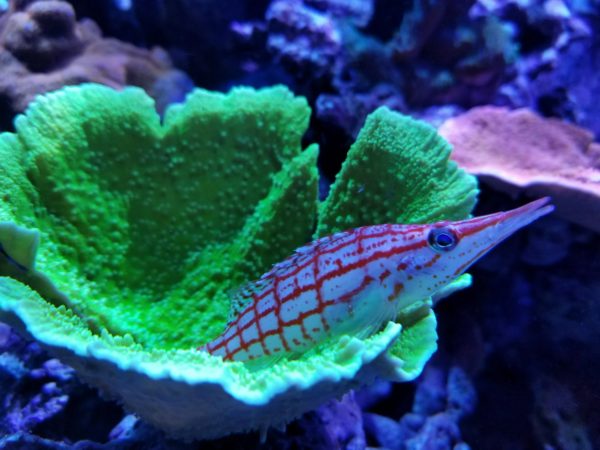
Best Diet for Longnose Hawkfish
Because it is a carnivorous predator, feed it live and frozen meats. You can also give them dried foods, although this requires some instruction. Do not put them on a single food for an extended period. Instead, feed fish a varied diet of insects, crabs, tiny fish, and other meaty things.
How often should you feed Longnose Hawkfish?
Like most saltwater fishes, you should feed the Longnose Hawkfish twice daily. Only give them as much food as they can consume in two-three minutes.
They’ll sit on rocks and reefs, waiting for food to fall nearby and snatching it as it approaches.
Longnose Hawkfish Behaviour and Temperament
The Longnose Hawkfish has distinct behavioral features that set it apart from other saltwater fish. Because they engage with the surroundings rather than ignoring them, fishkeepers believe them to be very curious and full of personality.
Are Longnose Hawkfish Lone or Societal in Nature?
Rather than swimming around the tank looking for food and protecting their territory from other fish, Longnose Hawkfish will settle in a few areas and scout the area for food and potential threats.
It helps them to swiftly learn their tank’s territorial limits and the behavioral peculiarities of their tank mates, which can intimidate species that might fight back.
Longnose Hawkfish spend time in corals’ natural habitat and reside in rock outcrops, which are excellent food sources.
You’ll have to emulate this by giving them plenty of rock formations and caves to hide and seek privacy.
Longnose Hawkfish are known for their secrecy at times and their huge eyes, which let them detect light in deep water.
Despite the lack of a swim bladder, this species can swim at incredible speeds for brief periods.
The advantage of not swimming milder is that they can dart around the tank quickly without altering the swim bladder pressure.
It allows them to seize passing prey in the substrate with quick bursts of speed.
Longnose Hawkfish Tank Mates
Ideal Longnose Hawkfish Tank Mates
Long Nose Hawkfish are renowned for their territorial tendency and should not be housed with other fish inside the tank. However, if you prefer keeping them with other fish, you’ll need to select their tank mates carefully. It is a vicious predator which will gladly consume small fish and other invertebrates for food.
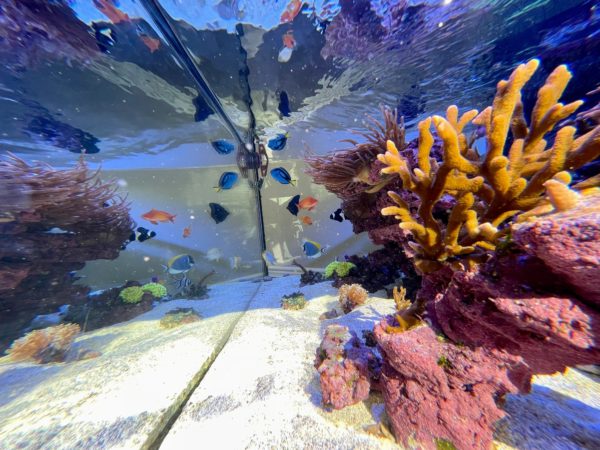
Finding fish that are similarly temperamental and large – but not too huge to represent a hazard – is the best strategy. According to experts, Longnose Hawkfish ought to be your last item to enter any tank to avoid them from seeing their tank mates as prey.
If tank mates are now in the Hawkfish’s domain, they will have to pay attention to them and only pursue them if it becomes overly hungry.
Caution: Do not mix them in with other hawkfish, or they will battle to the death. Only do this if you have a large tank with several hundreds of gallons. Most aquarists simply add a single hawk to their tank to reduce in-fighting.
You can adjust the decorations to keep them occupied if they become too aggressive.
Our recommendations for the best, similarly sized, semi-aggressive tank mates for Longnose Hawkfish:
They’re territorial and semi-aggressive, which is exactly the type of tank mate your Hawkfish will avoid. If you opt to raise Damselfish with Hawkfish, ensure they have many swimming rooms and hiding places. Aim for a tank with at least 100 gallons to avoid excessive fighting. Damselfish can be found in various colors, including an extraordinarily dark blue.
- Dottyback
Dottybacks are vividly colored, around the same size as Damselfish, and typically avoid them. Dottybacks, despite their timidity and shyness, can hold their own against the Longnose Hawkfish species. They have nearly identical care requirements to Hawkfish and should be able to coexist in the same aquarium.
- Giant Gobies
Because gobies are bottom dwellers, their range overlaps with Longnose Hawkfish, posing a threat. Small gobies should not be placed since hawkfishes can eat them. Larger species such as the Diamond Watchman Goby and the Orange Spotted Goby, on the other hand, grow big enough for the 4-inch tall hawkfish to avoid them. You must supply them with a large tank; else, they will harass one another excessively.
Because they are comparable in size and are bottom dwellers, they get along great with Longnose Hawkfish. It is feasible for these fish to approach too close to Hawkfish, but they can send them away. To remain out of the Hawkfish’s way, make sure they have a big enough tank and plenty of hiding spots.
- Basslets
They are a semi-aggressive species that only fight between themselves. They reach a maximum size of 3 inches and get along with many tank mates. They are bottom feeders who prefer to hide among the rocks.
When choosing tank mates, remember the rule of thumb: they shouldn’t be bite-sized, especially invertebrates and crabs. The Longnose Hawkfish’s hunting instincts will be heightened due to this.
Bad Tank Mates for Longnose Hawkfish
The longnose hawkfishes are highly territorial and aggressive, especially with small fish, and therefore if you plan to house it together with other fish species, don’t put it in the same tank with very small fish.
Breeding Longnose Hawkfish
All fish breeds usually start their early stages as females but usually can transform into males later in their lives. The male of the fish is known to court the female when the time for spawning is around the corner. If you are keen enough and have a pair of males and females, you may notice some courtship dance in your aquarium. However, it is unfortunate that even when successful spawning occurs in the tank, the offspring may not mature into adults.
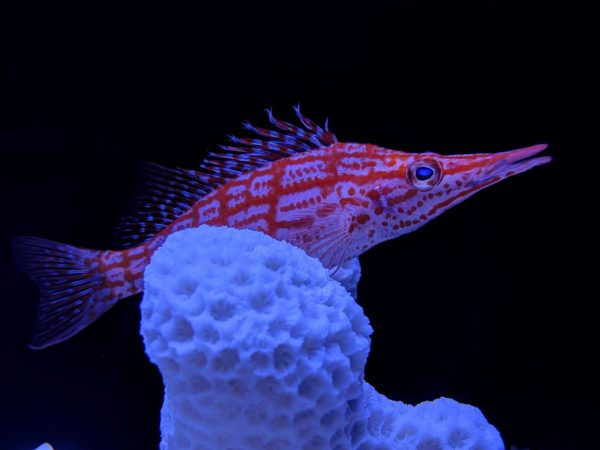
There haven’t been many reports of Longnose Hawkfish reproducing and their offspring growing to adulthood.
It helps to explain why they’re so expensive, at $100 or more, because even commercial fish farms find breeding difficult. You can, however, create optimal conditions in your tank and trust that your hawkfish pair will mate.
The first stage is to distinguish between the male and female. Because they’re so similar, it’s easier said than done. Males have darker stripes on their dorsal fins and are slightly larger than the females, although this difference isn’t usually consistent.
Longnose Hawkfish begin their lives as females and then transition into males later in life. Males are going to court females for spawning when they are ready. When the duo is ready to mate, you may see a few dance routines in your tank.
However, as previously stated, Longnose Hawkfish fry is extremely susceptible and may not survive to adulthood.
Longnose Hawkfish will battle to the death due to their territorial mentality. To avoid violence, you should put them inside the tank as juveniles.
When they hit adulthood, one may transform into a female when they hit adulthood, while the other may transform into a male. This happens only if they are much more dominating than the other.
They’ll always see each other as the enemy, not a mate, if their levels and size of aggression are the same.
Provide enough high-quality food to the pair to start the spawning process. To replicate their natural habitat, turn out the lights. The two fish would frequently swim together to the aquarium’s top.
Their eggs and sperm will be released into a cloud together, usually near the surface. The eggs can be tough to find, but you’ll notice them floating because they’re buoyant.
Please, you should not use a net to extract the overly delicate eggs as this may cause them harm. Use a container instead.
Longnose Hawkfish Breeding Level – Intermediate
Longnose Hawkfish Sexual Dimorphism
Longnose hawkfish are hermaphrodites who go through the stages of hermaphroditism to reproduce. The largest fish switches sex without a male in the ecosystem.
Longnose Hawkfish Common Diseases and Their Treatment
Hawkfish are a tough, well-developed species with strong immune systems. One of the major reasons they’re so famous among fish keepers is this.
They’re frequently the last fish inside the tank to succumb to illness. And only when anything bad happens with the tank does this happen. When they become ill, you can treat them just as effectively with medications and therapies like a prophylactic dip.
Facts About Longnose Hawkfish
- They prefer to hang around on coral reefs, particularly black coral and gorgonians.
- They enjoy jumping (put egg canopy or carton over the top to be able to keep them in and at the same time let light in).
- All Hawkfish start as females, but they can transform into more dominant males, slightly brighter and larger.
Are Longnose Hawkfish Right for You?
The longnose hawkfish, a beloved marine staple, is an ideal addition to a quiet setting with many places to sit and gaze out over its watery dominion.
FAQs
Is The Longnose Hawkfish Poisonous to Other Fish?
Other fish are neither poisoned nor toxic to Longnose Hawkfish. They do, however, have razor-sharp fangs that can rip through flesh.
Is Longnose Hawkfish Safe on The Reef?
Longnose Hawkfish prefer to swim toward reefs and rock formations in their natural habitat, searching for food. They have been seen nipping at fleshy corals and eating them. It suggests they’re not very safe in the vicinity of reefs.
Where Can I Purchase a Longnose Hawkfish?
Longnose Hawkfish for sale can be found at most pet stores, online businesses, and online forums in your area. They are, however, quite costly, ranging from $50 to $170+, varying according to the size, availability, and location.
Conclusion
The Longnose Hawkfish is a marine water aquarium fish that can make a great addition to your aquarium. It is highly territorial and aggressive, especially with small fish, and therefore, if you plan to house it together with other fish species, don’t put it in the same tank with very small fish.
Longnose Hawkfish has a lot to offer, from their magnificent appearance to their inquisitive personality and the relative ease they may be cared for.
No related posts.
